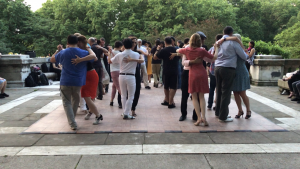No matter how hard you try (positively or negatively) you’re going to acquire a ‘Tango Reputation’. Meaning ? How you engage socially, how you dance, who you dance with, how ‘good’ you are, how often you dance, if you teach, where you teach, who you teach with, whether or not (if you teach) you dance only with your students or with others, if you teach others while dancing (tsk, tsk, tsk), whether or not you dance milonga, how good your milonga skills are, whether or not you lead and follow or not. Whether or not you hang, pull, push, compress, squeeze, employ tension, resistance, or force in your embrace. Whether or not you wobble when you walk, how stable you are or aren’t. If you are a social person or not. If you’re amenable to feedback or not. If you are ‘open’ or ‘closed off’’. If you’re easy to dance with, or ‘challenging’, and not in a good way. If you’re catching on quick or you’ve been at this while. Whether or not you sit most nights, and not by choice, or if it’s by choice because you have an attitude the size of Montana.
All of these things contribute to your ‘Tango Reputation’, they define you whether you want them to or not. These things are very similar to what is defined as “Tango Baggage” however, in this case your Tango Reputation is more about the social part than it is about the technique part, which is what “Tango Baggage” is all about. Your ‘Tango Reputation’ goes with you from Milonga, to Milonga, to Milonga. It doesn’t leave simply because you do. That stuff follows you for years to come. Quite literally what you do socially, desirably or undesirably, that noise follows you everywhere like a dog looking for a home. 🙁 And trust me when I say that you don’t want any part of that. Even if it is positive. The fact is that we would like to escape this thing especially if it’s negative, and even if it’s positive, just so that we can be treated as equal dancers if only for a little while. Our technique will give us away 2 steps in, and that will define you there after at a Milonga, no matter where you are. But you can at least walk into a room and not have the room groan “Them! Again ?”
A good piece of advice here is an old adage: Do unto others…. And nothing could be more true — Be kind, be gracious, be courteous … always. Because if you’re not, well let’s just say that 2 years from now when you’re somewhere in Poland, or Istanbul, or Sydney, and that’s not your home community, and you’re just ‘visiting’. Word will get around very quickly about who you are, where you come from, and what you’ve done. The tango gossip mill is notorious for finding these things out even before you put a foot on the floor! In other words, be careful out there.











